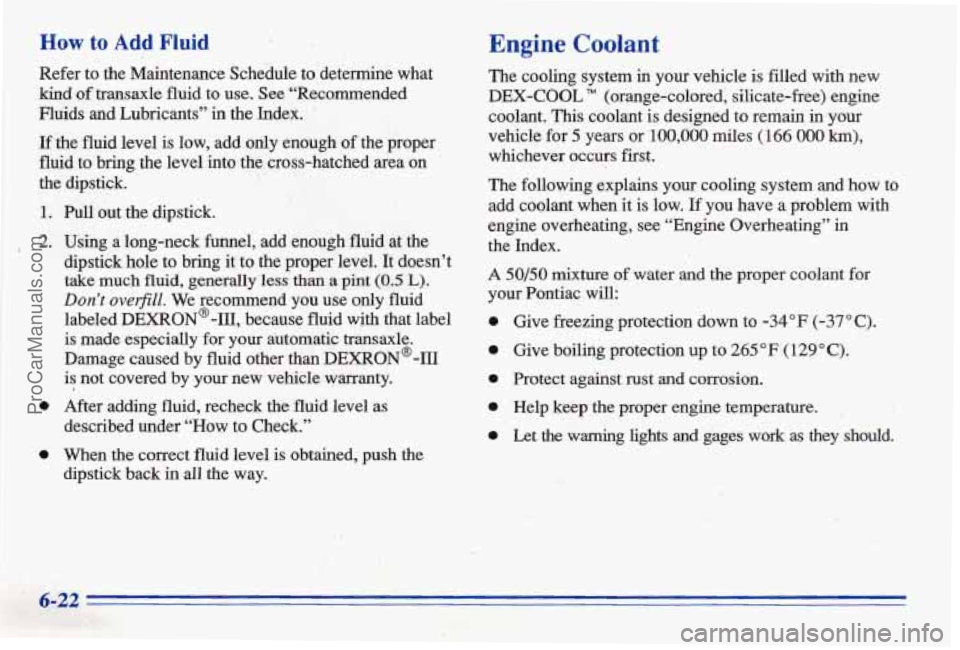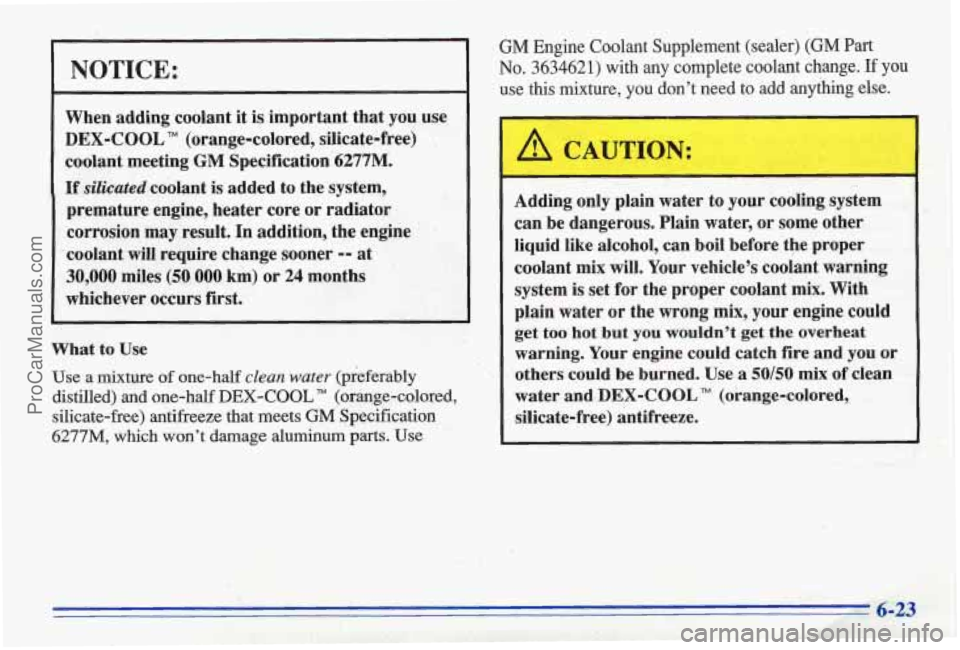Page 256 of 387
3800 Supercharged Engine (L67 - Code 1) (Option)
When you open the hood, ~011'11 see:
A. Engine Coolant Recovery Tank D. Engine Oil Dipstick G. Brake Master Cylinder
B. Battery
E. Engine Oil Fill Cap H. Air Cleaner
C. Radiator Pressure Cap F. Automatic Transaxle Fluid Dipstick I. Windshield Washer Fluid Reservoir
6-11
ProCarManuals.com
Page 267 of 387

How to Add Fluid
Refer to the Maintenance Schedule to determine what
bind of tmhsaxle fluid to use. See 6‘Recomended
Fluids and Lubricants” in the Index.
If the fluid level is low, add only enough of the proper
fluid to bring
the level into the cross-hatched area on
the dipstick.
Pull out the dipstick.
Using a long-neck funnel, add enough
Md at the
dipstick hole to bring it to the proper level. It doesn’t
take much
fluid, generally less than a pint (0.5 L).
Don’t overfiI2. We recommend you use only fluid
labeled
DEXRON*-III,, because fluid with that label
is made especially for yo& automatic transax18e.
Damage caused
by fluid other than DEXRON’@-III
is not covered by your new vehicle warranty.
After adding fluid, recheck the fluid level as
described under “How to Check.”
When the correct fluid level is obtained, push the
dipstick back in
all the way.
Engine Coolant
The cooling system in your vehicle is filled with new
DEX-COOL (orange-colored,
silicate-free) engine
coolant.
This coolant is designed to remain in your
vehicle for 5 years or 100,000 miles (166 000 km),
whichever occurs first.
The following explains your cooling system and how to
add coolant when it is low.
If you have a problem with
engine overheating, see “Engine Overheating” in
the Index.
A 50/50 mixture of water &d the proper coolant for
your Pontiac will:
e
e
0
0
0
Give freezing protection down to -34°F (-37°C).
Give boiling protection up to 265 OF (1 29 O C).
Protect against rust and corrosion.
Help keep the proper engine temperature.
Let the warning lights and gages work as they should.
ProCarManuals.com
Page 268 of 387

NOTICE:
When adding coolant it is important that you use
DEX-COOL TM (orange-colored, silicate-free)
coolant meeting
GM Specification 6277M.
If silicated coolant is added to the system,
premature engine, heater core or radiator
corrosion may result. In addition, the engine
’ ‘ .
-coolant will require change sooner -- at
308,000 miles (50 000 km) or 24 months
whichever occurs first.
What to Use
Use a mixture of one-half clean water (preferably
distilled) and one-half
DEX-COOL (orange-colored,
silicate-free) antifreeze that meets
GM Specification
6277M, which won’t damage aluminum parts. Use
GM Engine Coolant Supplement (sealer) (GM Part
No. 3634621) with any complete coolant change. If you
use this mixture, you don’t need to
add anything else.
L
Adding only plain water to your cooling system
can be dangerous. Plain water,
or some other
liquid like alcohol, can boil before the proper
coolant mix will. Your vehicle’s coolant warning
system is set for the proper coolant mix. With
plain water
or the wrong mix, your engine could
get too hot but you wouldn’t get
the overheat
warning. Your engine could catch fire and you or
others could
be burned. Use a 5060 mix of clean
water and
DEX-COOL TM (orange-colored,
silicate-free) antifreeze.
ProCarManuals.com
Page 269 of 387
NOTICE:
If you use an improper coolant mix, your engine
could overheat and be badly damaged. The
repair
cost wouldn’t be covered by your
warranty.
Too much water in the mix can freeze
and
crack the engine, radiator, heater core and
other parts.
If you have to add coolant more than four times a year,
have your dealer check your cooling system.
NOTICE:
If YOU use the proper coolant, you don’t have to
add extra inhibitors or additives which claim to
improve .the system. These can be harmful.
Checking Coolant
When your engine is cold, the coolant level should be
at FULL COLD or a little higher. When your engine is
warm, the level should be up to FULL HOT or a
little higher.
ProCarManuals.com
Page 270 of 387
LOW
COOLANT
If this light comes on,
it means you're
low on
engine coolant.
Adding Coolant
If you need more coolant, add the proper mix at the
coolant recovery tank.
A CALJTION:
lhrning the radiator pressure cap when the
engine and radiator are hot can allow steam
and
scalding liquids to blow out and burn you badly.
With the coolant recovery tank,
you will almost
never have to
add coolant at the radiator.
Never turn the radiator pressure cap
-- even a
little -- when the engine and radiator are hot.
Add. coolant mix at the recovery tank, but be careful not
to spill it.
r I
You can be burned if you spill coolant, on hot
engine parts. Coolant contains ethylene glycol,
and
it will burn if'the engine parts are hot
enough. Don't spill coolant on
a hot engine.
6-25
ProCarManuals.com
Page 271 of 387
Radiator Pressure Cap
NOTICE:
Your radiator cap is a 15 psi (105 kPa)
pressure-type cap and must be tightly installed
to prevent coolant loss and possible engine
damage from overheating. Be sure the arrows
on the cap line up with the overflow tube on
the radiator filler neck.
1 I --$,. .: :; ' -%.Thermostat .
Engine coolant temperature is controlled by a thermostat
in the engine coolaxit system. The thermostat stops the
flow of coolant through the radiator until the coolant
reaches a preset temperature.
Power Steering Fluid
When to Check Power Steering Fluid
It is not necessary to regularly check power steering
fluid unless you suspect there is a leak in the system or
you hear
an unusual noise. A fluid loss in this system
could indicate
a problem. Have the system inspected
and repaired.
6-26
ProCarManuals.com
Page 312 of 387
L36 Engine Accessory Belt
C
The L36 engine uses an engine accessory belt. This
diagram shows the features connected and the routing.
See “Maintenance Schedule”
in the Index for when to
check the belt.
A.
B.
C.
D.
E.
E
Power Steering
Alternator
Air Conditioning
Idle
Crank
Coolant
Pump
6-67
ProCarManuals.com
Page 313 of 387
L67 Engine Accessory Belt
The Supercharged 3800 (L67) engine uses two accessory
drive
belts. The inner belt drives the alternator, power steering
pump, coolant pump and air conditioning. The
outer belt drives the supercharger, Each belt has its
own
tensioner and idler pulley. See “Maintenance Schedule”
in the Index for when to check the accessory drive belts
and the supercharger oil level. Have your dealer check
the oil level in the supercharger.
1. Front Belt
2. Back Belt
A. Alternator
B. Power Steering Pump
C. Crank
D. Supercharger
E. Coolant Pump
E Air Conditioning
ProCarManuals.com